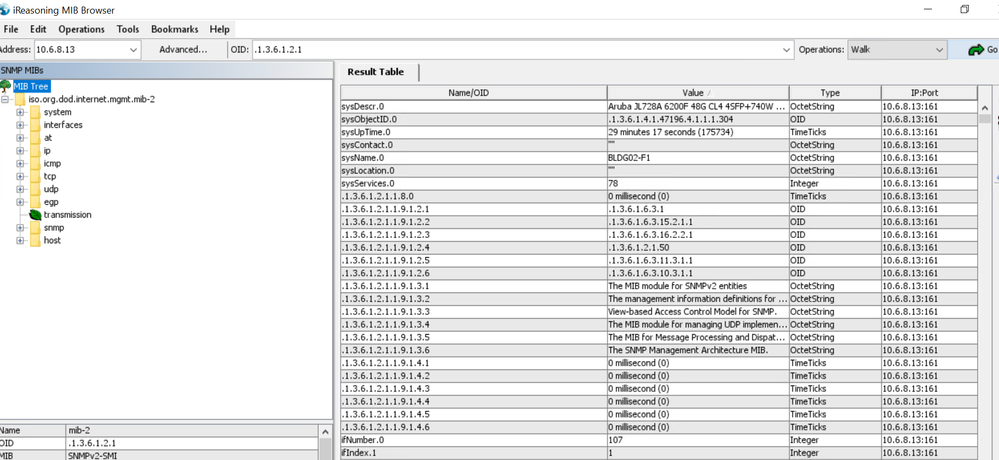How to use SNMPWALK? First of all you have to get Snmpwalk from here. It's better to download the latest stable version.
Once you have downloaded the tool and extracted it from the archive. If you are on a Windows OS it's enough to extract it from the .zip archive. Once you have the snmpwalk.exe file on your computer open the CMD (Start, search cmd and hit Enter). The 'black window' will popup. Locate the snmpwalk.exe file and drag it to that black window. Now you have to enter the right command.
The SNMP Walk Tool confirms SNMP communication with the remote device and shows you which OIDs are responding. SNMP Walk is located on the Orion Server tool. Log in to the polling engine that your node is assigned to via remote desktop. Navigate to the directory where the SNMPWalk program file exists, and run it. Enter the IP address of the. SNMP Tester (5 MB) The idea of this program is to have a tool that enables you to debug SNMP activities. To find communication and/or data issues in SNMP monitoring configurations. If the SNMP connection works with this test program, it also works with PRTG.
MIB Walk gives you a complete list of all supported MIBs and OIDs. SNMP Walker: Know the value of each OID on a device. MIB Walk pulls the value of each OID in the supported MIBs. Determine the name for each OID. It uses the SolarWinds MIB database ( 1M unique OIDs) to verify the common name for each OID and corresponding MIB. The SNMP Walk tool may retrieve a large amount of SNMP data from the selected device depending on the specified root OID. For the list of supported encryption protocols, see 'SNMPv3 Credentials for Discovery and Management' in Data Collection Techniques. You can also define the SNMP Walk settings in the Administrative Shell. The (Management Information Base) MIB Walk tool walks the SNMP tree for a target device and pulls the value of each OID in the supported MIBs. Use the MIB Walk tool to find out what MIBs and OIDs are supported on a particular device. MIB Walk uses the SolarWinds MIB database to determine the common, human-readable name for each OID and the MIB.
See below:
Thanks to this installer you will be able to start snmpwalk just by digiting 'snmpwalk' on your cmd 'black window'. All you have to do is to download that .exe and install it.

Snmpwalk is a great tool that will help you to test SNMP connectivity to one or more devices. It will check if your computer can connect via SNMP. If some ACL or firewall is blocking the snmp access the snmpwalk will fail. The same will happen if the SNMP community string (aka password) is wrong. Corel draw x3 portable full crack pc.
Snmp Walk Tool Windows 10
Testing Device connectivity using snmpwalk
We have this scenario. You want to check the connectivity to a Cisco router that has IP address 192.168.1.1 - This router is configured with SNMP V2c, and its community string is public
In order to test the connectivity and in order to check if the community string is right you can run the following command:
Snmpwalk Parameters
Here is the meaning of the parameters that we use in our examples: Los santos rock radio.

- -Os print only last symbolic element of OID
- -c set the community string
- -v specifies SNMP version to use
Snmpwalk Tool
Command example
Waves bass slapper vst. This is the format of the command that we use in our examples:
Snmpwalk timeout
The timeout message Timeout: No Response from 192.168.1.1 can appear if:
- there is a real timeout - it happens very rarely though:
- there is a firewall blocking SNMP access to the 192.168.1.1 device
- there are specific ACL configured in the devices that block UDP 161 access to the 192.168.1.1 device
- the snmp community string provided is wrong
Snmp Walk Tool Mac
Snmpwalk works well
In this example we can see that snmpwalk went through. It means that:
- there is SNMP communication with the device 192.168.1.1 on UPD port 161
- there are no ACL or firewallss that are blocking the communication
- the snmp community string provided is right
Snmpwalk Tool
If you have questions or comments feel free to contact me or leave a comment below
